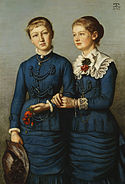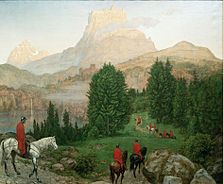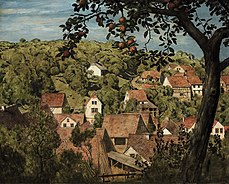Hans Thoma

You can help expand this article with text translated from the corresponding article in German. (February 2015) Click [show] for important translation instructions.
|
Hans Thoma (October 2, 1839 – November 7, 1924) was a German painter.
Biography

He was born in Bernau in the Black Forest, Germany. Having started life as a painter of clock faces, he entered in 1859 the Karlsruhe academy, where he studied under Johann Wilhelm Schirmer and Ludwig des Coudres. He subsequently studied and worked, with but indifferent success, in Düsseldorf, Paris, Italy, Munich and Frankfurt, until his reputation became firmly established as the result of an exhibition of some thirty of his paintings in Munich. He died in Karlsruhe in 1924 at the age of 85.
Style
In spite of his studies under various masters, his art has little in common with modern ideas, and is formed partly by his early impressions of the simple idyllic life of his native district, partly by his sympathy with the early German masters, particularly with Albrecht Altdorfer and Lucas Cranach the Elder. In his love of the details of nature, in his precise (though by no means faultless) drawing of outline, and in his predilection for local coloring, he has distinct affinities with the Pre-Raphaelites.
Works

Many of his pictures have found their way into two private collections in Liverpool. A portrait of the artist, and two subject pictures, The Guardian of the Valley and Spring Idyll, are at the Galerie Neue Meister; Eve in Paradise and The Open Valley at the Städel. Other important pictures of his are Paradise, Christ and Nicodemus, The Flight into Egypt, Charon, Pietà, Adam and Eve, Solitude, Tritons, besides many landscapes and portraits.
He also produced numerous lithographs and pen drawings, and some decorative mural paintings, notably in a café at Frankfurt, and in the music room of the Alfred Pringsheim house in Munich.
Gallery
- Selected works
-
Still life with a hare, pheasants and a lobster
-
Diana under the tree
-
Kunstschriftsteller Conrad Fiedler
-
Hans Thoma - Summer
-
Die Berge von Carrara
-
Die Gralsburg
-
Landscape
-
Versuchung auf dem Berge
-
December
-
June
References
- This article incorporates text from a publication now in the public domain: Chisholm, Hugh, ed. (1911). "Thoma, Hans". Encyclopædia Britannica (11th ed.). Cambridge University Press.
External links
- German masters of the nineteenth century: paintings and drawings from the Federal Republic of Germany, a full text exhibition catalog from The Metropolitan Museum of Art, which contains material on Hans Thoma (no. 91-95)















